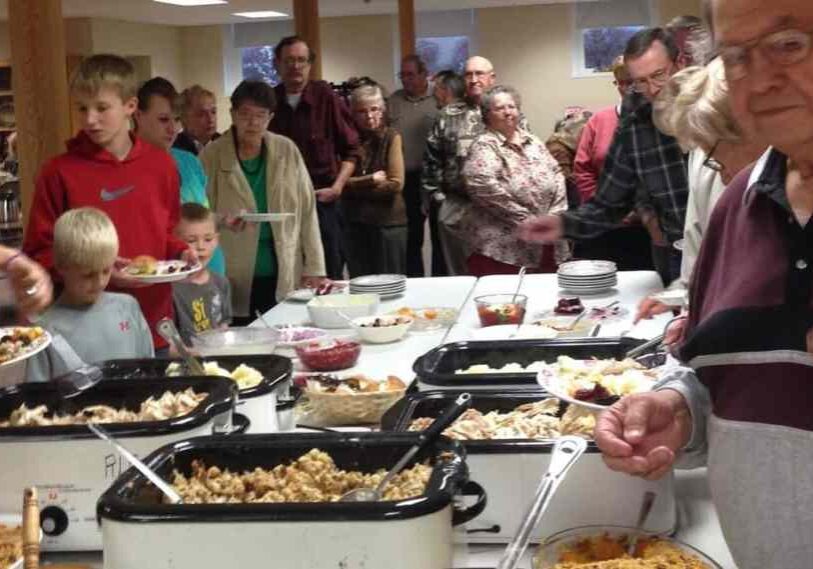Owl Center Puts Houston on the Map

Editor’s UPDATE (August, 2023): This fall, the International Owl Center is co-hosting the 2023 World Owl Conference, being held in nearby La Crosse/Onalaska, WI. Participants from as many as 30 different countries typically attend this event which has been held sporadically since 1987. Previous World Owl Conferences have been held in India, Portugal, The Netherlands, Australia and Canada; the 2023 conference is the first ever held in the United States. Conference participants attend workshops, research presentations, field trips, and a banquet featuring an Owl Calling Contest. To learn more about the October 23-27 conference—or to register to attend—visit the World Owl Conference website or Facebook page.
HOUSTON — People love owls. Just ask the folks of Houston, Minnesota, where a few weeks ago more than 1,600 people participated in the annual International Festival of Owls. They came to look at owls, learn about owls, and even eat pancakes in the shape of owls. People of all ages apparently can’t get enough of these amazing, mysterious birds.
Why do people love owls? Maybe it’s in that word…mysterious. With few exceptions, owls come out mostly at night, making it difficult to ever see them in the wild. If you do catch a fleeting glimpse of one, it’s probably only in shadowy silhouette as the owl glides through a forest in near total silence. We often hear “hoots” but those lonely, haunting calls seem like secrets being shared.
So, why do people love owls in Houston, Minnesota? That’s an easier question to answer. It all started over two decades ago when a few key people, some imaginative thinking, and one very special owl came together to create what has become one of the most unique nature centers not just in Minnesota but in the United States. You could even say the world.
Alice arrives
In 1996 the city of Houston made plans to create a nature center to serve as the trailhead for the Root River Trail. Karla Bloem, a Spring Grove, Minnesota, native and Luther College graduate, accepted the challenge to make the center a reality. It was a great fit. “I grew up on a farm loving the outdoors and animals and doing 4-H,” Karla says. “I took a special interest in birds, especially hawks, and later became a falconer.”
Connecting with the National Eagle Center in nearby Wabasha, helped Karla imagine what might be possible in Houston. “People advised me to start programs even before we had a facility,” she says. “We started collecting exhibits of local wildlife, like gophers and snakes, but having a live animal on site became a major goal.”
That’s where Alice comes in, a permanently-injured, non-releasable Great Horned Owl who came to live in Houston in 1998. Alice quickly became quite the local celebrity, and in 2003 a festival was held to celebrate her birthday (“hatch-day,” technically) on the first weekend in March.
“With very little publicity almost 300 people showed up,” remembers Karla. “It was a fun day; people came from all over to see Alice and learn about owls. It confirmed for us that people have a special interest in owls. We decided to do it again and we’ve been having an Owl Festival the first weekend in March ever since.”
Alice continued to attract even more visitors, the Nature Center building was constructed in 2001, and by 2008 Houston’s Nature Center was now known for its work with and presentations of owls. By 2010 live internet streams were making it possible for people from all over the world to meet Rusty and Iris, two non-releasable owls used for vocal research projects, and other owls now permanently residing in Houston. The Center currently has seven owls in residence; two are retired, including Alice (whose recent birthday was her 26th).
The Houston Nature Center still exists but is not the same as the Owl Center, which opened in its current storefront location, the former Skifton Department Store, in 2015.
International Owl Center
Establishing the World Owl Hall of Fame as part of the March Festival increased the Center’s national and international prominence. Soon owl biologists from around the world were traveling to Houston each year to speak at the Festival.
“There was no other facility dedicated to teaching people about owls anywhere in North America,” says Karla, now serving as the Owl Center’s Executive Director. “Our Festival is the original full-weekend, all-owl event in the United States. By 2011 we established a separate non-profit known as the International Owl Center (IOC), where our mission is to make the world a better place for owls through education and research.”

International Owl Center Kids Owl Art Contest, 2023: 1 st Place Winner, Alexander Xu (age 16), California. (Courtesy of International Owl Center)
That mission comes alive through year-round programs for all ages, research projects, school connections and more. And, of course, through the annual Festival that spreads throughout the entire town of Houston for fun learning activities like bus trips, a community pancake breakfast at Cross of Christ Lutheran Church (where you’ll find those funny pancakes), DIY owl nest building, and the slightly-weird but definitely unique opportunity to examine owl pellets (“remember, it’s puke not poop”) to learn what owls eat. One clue: you won’t find any vegetables.
2023’s special guest presentation was given by Roar Solheim from Norway. Each year an International Children’s Art Contest is also a special part of the Festival.

International Owl Center Kids Owl Art Contest, 2023: 3 rd Place Winner,Chaninan Keaaatchokanan (age 18), Thailand. (Courtesy of International Owl Center)
The contest has grown into a highly competitive and artistically stunning array of children’s art, with a typical year bringing in more than 2,000 entries. Over 2,000 entries arrived from 20 states and 34 different countries in 2023.
Typically, children from Ukraine submit entries to the art contest. But in 2022 war broke out. So, last March the IOC auctioned off children’s owl-art to raise funds to support UNICEF’s work with the children in Ukraine. More than $100,000 was raised from the sale of 59 pieces of art.
The Festival works because it has access to space throughout Houston — the town’s high school is Festival central — and a group of enthusiastic volunteers. (A group of owls, just for fun, is called a “parliament.”) But finding good and workable space during the year to offer its ongoing programs and research projects programs has been a challenge for the International Owl Center.
“Our current location is easy to find,” says Karla, “but it isn’t suitable for our owls to actually live there. They have to commute from a facility out in the country. There are people challenges, too. For example, when we offer our free ‘neighbor weekends’—Iowa in December, Minnesota in January, and Wisconsin in February—our amenities get a bit stretched. We only have one toilet, for example. We’re excited about our plans to improve all that.”
What do those plans look like?
“We’ve purchased property near the Houston Nature Center and are developing concepts for a brand-new Owl Center facility with walk-through aviaries where our owls can live full-time and where visitors will be able to see them up close. Existing owl centers in Europe are giving us great ideas. Planning and fundraising efforts are underway. If all goes well that building could be a reality in 2025.”
Experts say there may be as many as 270 different kinds of owls around the world. The top owl people on the planet are usually thought of as coming from places like Germany, India, South Africa, Canada, and Nepal. Let’s happily and proudly add another location to that list: Houston, Minnesota.
The International Owl Center is open Fridays, Saturdays, Sundays and Mondays, from 10-4 with programs at 11 a.m. and 2 p.m. For more information, visit International Owl Center or call (507) 896-OWLS (6957). Visit Festival of Owls to learn more about the festival held each March.






